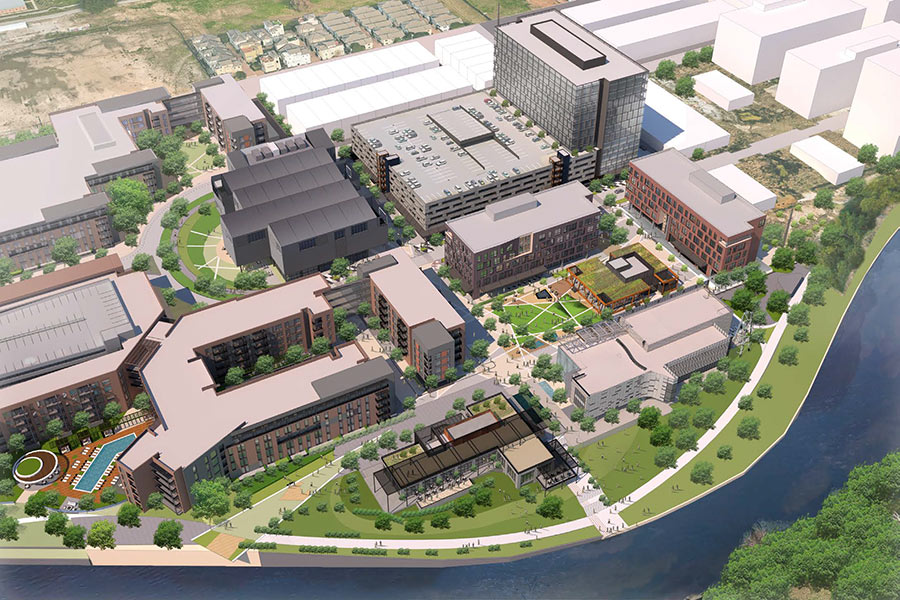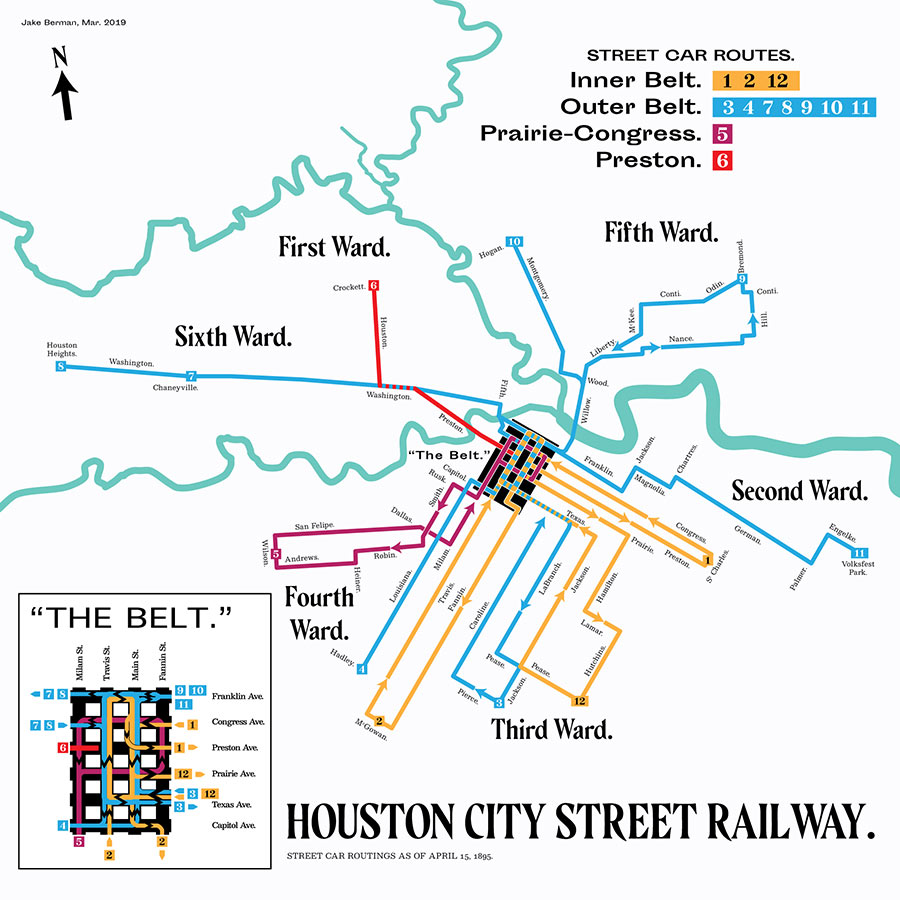
What’s the status of those plans for a big Intermodal Transit Center at North Main and Burnett just north of I-10 Downtown, meant to link commuter rail and bus lines to the coming northern reaches of Metro’s existing rail line?
L.A.’s Ehrenkrantz Eckstut & Kuhn Architects are now showing off this rendering of the terminal at the company’s website, along with the kind of encomium that usually accompanies abandoned or massively scaled-back projects. Rail-watcher Christof Spieler reported back in March that the terminal project on the North Line had been “shelved (for now, at least)”; plans to extend the new East End Line to that station were abandoned last year.
- Houston Northern Intermodal Transit Facility [Ehrenkrantz Eckstut & Kuhn Architects]
- Proposed Metro Intermodal Terminal [HAIF]
- We have (part of) a contract! [Intermodality]
- The New New Metro Rail Map: University Line Takes the Uptown Express, TSU Takes a Hike [Swamplot]
Rendering: Ehrenkrantz Eckstut & Kuhn Architects





Too bad…that ice mountain igloo thing in the background would have been wonderful.
Houston has become the world leader in unrealized “grand” renderings.
John, Houston isn’t alone. Capital markets are still pretty much frozen up, and there’s NOTHING new happening in commercial real estate anywhere in the country right now. It only seems like we’re special to people who have specialized knowledge of the Houston market and not others.
The biggest lost of this getting delayed is the movement of the Greyhound station in Midtown to the intermodal center. If you want to talk about eyesore, that is one of them.
Wow…I don’t think I’ve ever seen “encomium” used in a sentence.
Niche, I travel extensively and keep in touch with other architects all over the country, so I’m well aware of commercial real estate issues elsewhere. My comment was not related to current economic conditions, rather to the rather common practice in Houston of developers releasing architecturally significant renderings of projects that produce lots of press and publicity; only to actually build projects that are much less than the renderings promised. The Houston Planning department is toothless and Houston’s lack of any architectural standards or planning guidelines allow this to be common practice. Take a look at the renderings and promotion of the Heritage Plaza garage that now defaces the West view of the downtown skyline. It was covered in a screening structure that was to be fully vegetated. The project’s design even won a AIA award. The design was obviously bastardized in a way that may not have been allowed in Chicago, SFO, or NYC. Do you remember the renderings and promotion of the former HISD property at Richmond and Weslayan? The sea of concrete that resulted with the new Costco is not the urban, walkable development promised. There are dozens of other examples of this, but I assume you get my point. I also assume that when the Intermodal Center is built, it will look like a suburban mall (like Toyota Center), instead of anything resembling these renderings. I will be thrilled to be wrong.
Architectural standards is kind of oxymoronic.
Design standards is maybe what you are going for, but architectural sounds better to the delusional central planning types that think an all powerful planning/zoning commission is the way to make things better.
Our lack of that is what a lot of people love about this city. It’s real and alive versus being planned to the last detail seeming false.
kjb434, I’ve always heard that refrain, “Houstonians love the city for its wild unplanned ways, blah, blah, blah.” I think its a crock. Developers love it. Crappy developers love it even more. The furor over the Ashby Highrise indicates that people don’t really love the lack of planning or “design” standards here. It’s not coincidence that the areas of town with the highest property values are planned and have strict standards in place; River Oaks, West U., Uptown, Bellaire, the Memorial Villages. Those high values indicate what Houstonians really love. None of these areas stifles architectural expression or integrity. I don’t want Houston to look like Sugarland, but I strongly believe, for instance, that the current explosion of development in the Washington Corridor could have resulted in one of the best urban corridors in the country if there were very basic guidelines in place; like sidewalks wider than 3 feet, parking in back or sides of projects, and landscaping requirements that are not laughable, etc. Washington civic groups have been lobbying the COH to adopt these basics for nearly a decade. Of course, the COH did not, and now even with some incredible projects like the new benjy’s in place, the corridor itself has missed the chance to be a much better place.
My background is commercial real estate development–the side of things where people actually make decisions about what to build and where–and I have traveled and kept up with these issues all over the country. Houston certainly has more than its fair share of projects that have been put on hold, however we definitely had more projects going forward over the last several years than just about anywhere else in the country; so that’s a problem I’m happy to have had. But we’re far from being the only ones with project cancellations or redesigns. The first thing to come to mind is Dallas’ Victory complex. Or how about the Chicago Spire? And both of those cities have projects where the lenders found ways to stop providing loan advances in the middle of highrise construction, leaving partly-built skeletons to a questionable fate. Austin has several large projects that have been put on hold all up and down Lady Bird Lake, and certainly the build out of Domain has stalled. And these are all cities with growth driven by a relatively healthy and balanced economy and which did not participate in the pricing bubble. There are dozens (plural) of dead highrise projects in places like Las Vegas and S. Florida. The ones that got built are empty and have put so much downward pressure on the market as to have pummeled the net worth of innumerable homeowners. In that context, if you consider balance and restraint among developers to be Houston’s curse, then your curse is my blessing.
“Crappy developers love it even more.”
Ain’t that the truth
John,
As onerous as other cities regulations can be, developers actually like them more than Houston because they are predictable.
The lack of predictability in Houston makes more developers cringe. Let’s say you build a nice apartment complex that is aiming for higher end rents, then a trashy strip shows up next door. In places where heavy planning and regulation exist this wouldn’t happen.
Then why I’m not for that regulation? The regulation in the end removes the citizens and population out of the equation. The thing about Ashby was that the citizens stopped it. In a planning heavy environment, Ashby if proceeded couldn’t be stopped by the local citizens. And yes, many, many planning commissions and zoning boards have allowed unusual construction of high-rises in weird locations on purpose to change the fabric of a neighborhood. Would if we had a zoning board that decided that Bissonet would be a denser urban areas. All the homes become zoned as high density. Then if a developers buys they can build apartments and high-rises. The citizens can’t stop it.
Also, there are many high value areas that are completely unplanned. Uptown has lots of lack of planning. The only planning there is what the Uptown Management District is enforcing, but that is cosmetic. The properties are independent and can do what they want. Much of the Heights? Washington Ave? I consider these areas to be high property value areas. There are enough $300k to $700k properties to consider these areas higher end. The beauty in the lack of planning allows for these areas also to have lots of lower price dwellings in the area. The Memorial Villages, River Oaks, and West U have no restrictions on what gets built. The architectural guidelines originally existing in River Oaks was tossed out many years ago.
TheNiche has a very good points on commercial projects in Houston compared to the rest of the country. Those of us that are in-tuned to the Houston market but not others think that we are the only ones that get all these cancellations or less than stellar versions of the original architectural concept.
kjb434,
It seems you have a one-dimensional view of regulation, including that it can’t be governed by citizens (or their representatives) and that it can’t be altered once in place. I personally do not agree that having citizens stop the Ashby project was a good thing or something to be proud of. It simply promoted the NIMBY mentality of too many Houstonians, and excused the COH from addressing the real problem which is the lack of planning guidelines and regulations that are fair and equitable to developers and homeowners alike. The fact that a very well-off group of “citizens” could affect the legal permitting process because they just don’t like a particular project, not because of any illegality on the part of the developer is flat-out wrong.
Also, there is nothing in good planning that will disallow the beauty of mixing housing priced at varied income levels. The best planning requires this. The worst, like Sugarland, the Woodlands, Greatwood specifically prevent it. All planning and regulation is not equal.
Regarding comments by TheNiche; I don’t entirely disagree, but absent the current economic conditions, Houston’s civic and private projects still fall short of other major cities. It doesn’t have to be this way. The bright spot here is non-profit development. There are few better designed and executed projects than Discovery Green and the redevelopment of Hermann Park.
I completely disagree about the situation with the Ashby outcome because it was stopped through a political process. I actually supported the project.
Sugar Land’s planning is strict, but most of it was in placed post master planned communities. Essentially the developer planned much of the proposed uses and the city didn’t not object. In recent years (about the last 10-15 years), Sugarland had codified their development pattern into a master plan for the city. The city is essentially built out. An area to the north where the airport and several industrial/warehouse developments exist has been zoned to maintain that use. Areas to the south that are undeveloped will pretty much be all single family homes that will have pretty good access to the towncenter/First Colony Mall area. Working with the city before on the several of their projects, they seem pretty open to changes as needed. It is important to know that the strict zoning in effect is more a preservation measure versus a planning one.
The Woodlands has no zoning or planning board. It’s developer planned community and has adjusted it as the market has adjusted. None of their planning is set in stone. The masterplan for their last village (Creekside Park) has changed about 10 times in the last 7 years. Some of it due to engineering realities, some of it due to market forces. Zoning can react that fast. A planner wants a certain density and won’t deviate whether the market tells they need too.
As for public and private projects falling below other cities, I beg to differ. Several of our master planned communities on the private side are nationally recognized (and not just the Woodlands). On the public side, I really don’t care if we have a signature public feature to market ourselves with. To me, private non-profit interests do a great job at get projects moving forward. The museums and many green spaces are very much funded outside of heavy taxpayer subsidy. Yes, they aren’t necessarily signature. The good part about that is the locals can enjoy them more.